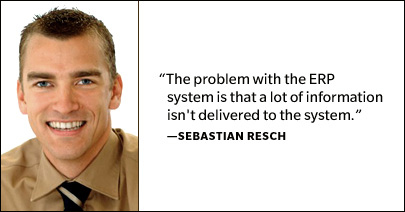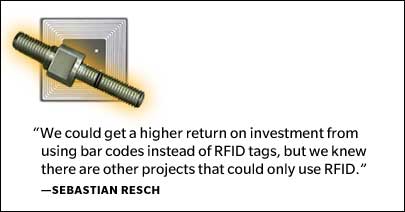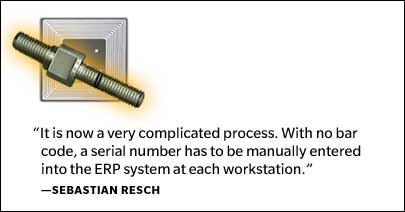Jun 19, 2006MTU Aero Engines, based in Munich, Germany, manufactures and repairs military and civil aircraft jet engines worth millions of dollars. Manufacturing an engine requires thousands of parts, which the company categorizes into three broad groups—A, B and C—according to their value. It's essential for those parts to be available when needed, but insufficient supplies of C parts—the smallest and least expensive category, comprised of such items as screws and bolts—can occasionally bring the engine-component production line to a standstill.
"Sometimes, there is a problem with C-part availability," says Sebastian Resch, RFID project leader at MTU. "We have a big assembly shop using 450 C parts, and sometimes there can be interruptions caused by poor C-part availability."
Much of the problem stems from the inability to obtain precise, real-time information about inventory levels from the enterprise resource-planning manufacturing application used to manage inventory and automate ordering and delivery of replacement inventory. For example, if 10 C-part screws were typically needed for a particular assembly but a certain item required more because of its condition, the ERP system would still calculate that 10 screws were used to complete the job.
"The problem with the ERP system is that a lot of information isn't delivered to the system," says Resch. "The number of parts required for each engine is static and very specific, whereas the requirements may vary. In addition, there are issues of shrinkage and parts rejected due to quality." The company needed to provide real-world input about the number of C parts actually used, as compared to the number estimated by the ERP system. To that end, MTU established its first RFID project, utilizing radio frequency identification technology to enable production line workers to alert the manufacturing system whenever more specific C-parts are required.
MTU had another reason to use RFID to tackle this problem. The company hoped the successful use of RFID in one area would open the door to wider RFID deployments throughout its operations, thereby improving efficiency.
The RFID trial lasted several weeks and went hand-in-hand with the introduction of a kanban card (or pull) production system for just-in-time manufacturing. Kanban—named for the Japanese word meaning "visible record"—uses cards to signal the need for more items. MTU used a handful of test cards to alert the IT system when new parts were required so orders could be scheduled to ensure delivery before the existing production line inventory was exhausted.
Kanban cards don't require the use of RFID or any other machine-readable identification; they can just be handwritten. MTU decided to add RFID so the cards could automatically update the ERP system as soon as they were dropped into the mailbox. The company could have used bar codes on each kanban card, which would have been less expensive than using RFID, but opted instead for RFID because it sees the project as an ideal way to introduce such technology to its employees.
"We could get a higher return on investment from using bar codes instead of RFID tags, but we knew there are other projects that could only use RFID," says Resch. "So an initial RFID project is the perfect way to introduce the technology to our employees."
Before MTU started its RFID project in Berlin, the company made sure the unions representing factory employees and production line workers using the new system understood the role of RFID and how it would affect them. It was key to stress to employees that RFID was being used to bolster and not undercut its employees. MTU is adamant that this approach is vital to successful RFID deployment. "Forget ROI calculations," says Resch. "There are ethical considerations."
In particular, Resch wanted to address concerns over the potential of RFID leading to job cuts. When he spoke to the employees, Resch guaranteed there would be no job losses resulting from RFID implementation. "Of course, there are fears about new technology," he says. "People read in the newspapers about RFID projects, and there is usually some talk about saving manpower and money."
There was also another reason for including production line employees in the development of the RFID system from its inception. "These are the people who know the process, as well as the weak points," says Resch. "We only know RFID."
The kanban cards themselves cost around €1 ($1.29) each, but putting a price on the effects of a production line halt isn't easy. "One interruption can cost thousands of euros if we can't meet a customer's delivery deadline," says Resch. "But, on the other hand, if the deadline is weeks away, production-line staff can work on other projects during a delay, and there is no detrimental cost at all to us."
Resch believes there is plenty of potential for RFID, not only in its jet-engine manufacturing operations in Berlin, but also in its maintenance, repair and overhaul operations (MRO) in Germany and around the world. The maintenance operations lines use thousands of C-level parts, compared with the 450 C-level parts on the manufacturing line. The additional number stems from the MRO's ability to work on engines from other manufacturers.
Employees on MTU's maintenance lines—in Germany's Hanover and Berlin plants, as well as at sites in the United States, China, Canada and Brazil—are required to inspect and, if necessary, service and repair all engine parts. There are also international regulations that could increase the value of RFID-tagging in MTU's operations.
"There is a legal requirement that any parts stripped from a turbine and able to be reinstalled have to have come from that same engine," says Resch. "Even if we are working on two identical engines, the parts can not be mixed."
Engine parts are placed in containers so those from a particular type of engine can be easily tracked. The operator at each maintenance station has to enter a code into the production-line management system for the item and engine before any work can be carried out. This redundant process could be automated by RFID-tagging the items and installing a networked RFID interrogator at each workstation to read and verify every tagged item.
"It is now a very complicated process. With no bar code, a serial number has to be manually entered into the ERP system at each workstation," says Resch. "That's a very repetitive and time-consuming system, but it is the way that every company in the industry works."
RFID is not the only solution MTU is considering to help streamline this operation, Resch says. It has already worked with 2D bar coding, but a decision on which technology will be used will be influenced by how its airline and aero engine customers decide to use RFID or other technologies for their own identification requirements.
Whether the company uses RFID to track its largest and most expensive parts, it's likely that it will play a positive role in helping track the cheapest and the smallest.



